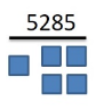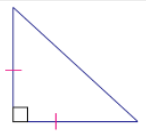7.3: Appendix C
- Page ID
- 51019
Solutions for Partner Activities
Chapter 2
Section 2.3
Partner Activity 1
Step 1: Add up both lengths to find the total length
\[2 \dfrac{3}{4}+1 \dfrac{1}{2}=\dfrac{11}{4}+\dfrac{3}{2}=\dfrac{11}{4}+\dfrac{6}{4}=\dfrac{17}{4}=4 \dfrac{1}{4} \nonumber \]
Step 2: Divide the part by the whole
\[\dfrac{\text {Sam}}{\text {Total}}=\dfrac{2 \dfrac{3}{4}}{4 \dfrac{1}{4}}=2 \dfrac{3}{4} \div 4 \dfrac{1}{4}=\dfrac{11}{4} \div \dfrac{17}{4}=\dfrac{11}{4} \times \dfrac{4}{17}=\dfrac{11}{17} \approx 0.65=65 \% \approx \dfrac{2}{3} \nonumber \]
Partner Activity 2
\[\begin{array}{l}
\dfrac{1 \text { hour }}{84 \text { miles }+92 \text { miles }}=\dfrac{1 \text { hour }}{176 \text { miles }} \\
\rightarrow \dfrac{132 \text { miles needed in one hour }}{176 \text { miles total in one hour }}=\dfrac{3}{4} \text { hour }=45 \text { minutes }
\end{array} \nonumber \]
Partner Activity 3
 \(\begin{array}{c}
\(\begin{array}{c}
\rightarrow 5285 \div 5=1057=\text { first number } \\
1057 \times 4=4228=\text { second number } \\
\text { Check it! } 1057+4228=5285
\end{array} \)
Section 2.4
Partner Activity 1
-
MMXLV = 1000+1000+(50-10)+5 = 2045
-
MDCCLXXXIX = 1000+500+200+50+30+(10-1) = 1789
-
1993 = 1000+(1000-100)+(100-10)+1+1+1 = MCMXCIII
-
5495 = 5000+(500-100)+(100-10)+5 = VCDXCV
Section 2.6
Partner Activity 1
-
- \(132_{\text {four}}\)
- \(200313_{\text {four}}\)
- \(100_{\text {four}}\)
-
- 15
- 278
- Undefined
Section 2.8
Partner Activity 1
- \(116_{\text {nine}}\)
- \(1030_{\text {four}}\)
- \(513_{\text {six}}\)
- \(21_{\text {three}}\)
- \(111110_{\text {two}}\)
Chapter 3
Section 3.2
Partner Activity 1
Answer: 265
Partner Activity 2
Answers vary
Partner Activity 3
- 408
- 246
Section 3.4
Partner Activity 1
\[\begin{array}{l}
5 \div 0=\text { undefined } \\
0 \div 5=0 \\
0 \div 0=\text { indeterminate }
\end{array} \nonumber \]
We know that \(18 \div 6=3\) because \(3 \times 6=18\), therefore. Using a similar approach, we know that \(5 \div 0 \neq 0\), since \(0 \times 0 \neq 5\)
Section 3.5
Partner Activity 1
- $14.47
- $3.65
- $16.32
Partner Activity 2
- \(12 \times 6 = 72\)
- \(10 \times 18 = 180\)
- \(8 \times 8 = 64\)
Partner Activity 3
- 321
- 229
- 15453
Section 3.6
Partner Activity 1
Answers vary. Samples are below:
- Here to Baker, CA
- The length of my bedroom
- The weight of a 2nd grader
Chapter 4
Section 4.2
Partner Activity 1
- The denominator is VERY MUCH less than the numerator, i.e. \(\dfrac{1}{10000}\)
- Both the denominator and the numerator are large numbers and they are very close in distance, i.e. \(\dfrac{999}{1000}\)
- The numerator is roughly half of the denominator, i.e. \(\dfrac{15}{31}\)
- The numerator is roughly a third of the denominator, i.e. \(\dfrac{21}{60}\)
Partner Activity 2
\[\dfrac{3}{8} \rightarrow \dfrac{1}{2}, \dfrac{5}{4} \rightarrow 1, \dfrac{2}{9} \rightarrow 0, \dfrac{4}{7} \rightarrow \dfrac{1}{2}, \dfrac{1}{3} \rightarrow \frac{1}{2} \nonumber \]
Section 4.3
Partner Activity 1
\[\dfrac{51}{684}+\dfrac{43}{684}+\dfrac{738}{684}=\dfrac{832}{684} \nonumber\]
OR
\[\dfrac{1}{8}+\dfrac{4}{5}+\dfrac{1}{9}=\dfrac{1}{360}+\dfrac{ }{360}+\dfrac{ }{360}= \dfrac{45}{360}+\dfrac{288}{360}+\dfrac{40}{360}=\dfrac{373}{360} \nonumber \]
Partner Activity 2
Division works. The rest do not.
Chapter 5
Section 5.2
Partner Activity 1
Factors: 1, 2, 3, 5, 6, 10, 15, 30
First four multiples: 30, 60, 90, 120
Partner Activity 2
Primes: 2, 3, 5, 7, 11, 13, 17, 19, 23, 29, 31, 37, 41, 43, 47, 53, 59, 61, 67, 71, 73, 79, 83, 89, and 97
Partner Activity 3
0, 1, negative = neither. 2 is the first prime number.
Partner Activity 4
- \(85=5 \cdot 17\)
- \(350=2 \cdot 5^{2} \cdot 7\)
- \(60=2^{2} \cdot 3 \cdot 5\)
Section 5.4
Partner Activity 1
2 feet; The GCF of (6, 8, 12) = 2
Partner Activity 2
Each packet contains 12 cards; The GCF of (24, 60, 48) = 12
Section 5.5
Partner Activity 1
120 cookies; The LCM of (15, 24) = 120
Partner Activity 2
- \(\dfrac{1}{12}\)
- \(\dfrac{1}{6}\)
- 14
Chapter 6
Section 6.2
Partner Activity 1


- Does not exist
Partner Activity 2
- A square is a rectangle
- Parallelogram
- A regular has all same sides and all same angles
Partner Activity 3
- 180
- 540
- 2340
- 360
Partner Activity 4
- 150
- 41
Section 6.3
Partner Activity 1
- Area is base times height, two dimensions
- Volume is base times height times width, three dimensions
Partner Activity 2
About \(12 \text { units}^2\)
Partner Activity 3
\(52 \text { units}^2\)
Partner Activity 4
\(24 \text { units}^3\)
Section 6.5
Partner Activity 1
-
\(1200 \text { inches}^2\)
-
\(225 \text { feet}^2\)
-
\(196838560.5 \text { miles}^2\)
-
\(37.68 \text { inches}^3\)


